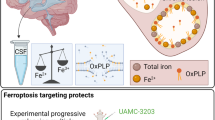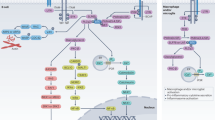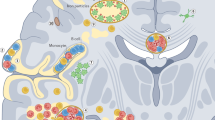Abstract
Demyelination is a common pathologic feature in many neurodegenerative diseases including infection with leprosy-causing Mycobacterium leprae1,2,3. Because of the long incubation time and highly complex disease pathogenesis, the management of nerve damage in leprosy, as in other demyelinating diseases, is extremely difficult. Therefore, an important challenge in therapeutic interventions is to identify the molecular events that occur in the early phase before the progression of the disease. Here we provide evidence that M. leprae–induced demyelination4,5 is a result of direct bacterial ligation to and activation of ErbB2 receptor tyrosine kinase (RTK) signaling without ErbB2-ErbB3 heterodimerization, a previously unknown mechanism that bypasses the neuregulin-ErbB3–mediated ErbB2 phosphorylation6,7,8,9. MEK-dependent Erk1 and Erk2 (hereafter referred to as Erk1/2) signaling is identified as a downstream target of M. leprae–induced ErbB2 activation that mediates demyelination. Herceptin (trastuzumab), a therapeutic humanized ErbB2-specific antibody9,10, inhibits M. leprae binding to and activation of ErbB2 and Erk1/2 in human primary Schwann cells, and the blockade of ErbB2 activity by the small molecule dual ErbB1-ErbB2 kinase inhibitor PKI-166 (ref. 11) effectively abrogates M. leprae–induced myelin damage in in vitro and in vivo models. These results may have implications for the design of ErbB2 RTK–based therapies for both leprosy nerve damage and other demyelinating neurodegenerative diseases.
This is a preview of subscription content, access via your institution
Access options
Subscribe to this journal
Receive 12 print issues and online access
$209.00 per year
only $17.42 per issue
Buy this article
- Purchase on Springer Link
- Instant access to full article PDF
Prices may be subject to local taxes which are calculated during checkout




Similar content being viewed by others
Change history
17 August 2006
In the version of this article initially published, the middle panel of Figure 4d incorrectly reported the percentage of demyelination in M. leprae–treated cultures. The percentage should be 67 ± 3.1 instead of 7 ± 3.1. The error has been corrected in the HTML and PDF versions of the article.
Notes
NOTE: In the version of this article initially published, the middle panel of Figure 4d incorrectly reported the percentage of demyelination in M. leprae-treated cultures. The percentage should be 67 ± 3.1 instead of 7 ± 3.1. The error has been corrected in the HTML and PDF versions of the article.
References
Stoner, G.L. Importance of the neural predilection of Mycobacterium leprae in leprosy. Lancet 2, 994–996 (1979).
Job, C.K. Nerve damage in leprosy. Int. J. Lepr. Other Mycobact. Dis. 57, 532–539 (1989).
Johnson, P.C. Peripheral nerve pathology. in Textbook of Neuropathology, 3rd edn. (eds Davis, R.L. & Robertson, D.M.) 1233–1323 (Baltimore, Lippincott William & Wilkins, 1997).
Rambukkana, A., Zanazzi, G., Tapinos, N. & Salzer, J.L. Contact-dependent demyelination by Mycobacterium leprae in the absence of immune cells. Science 296, 927–931 (2002).
Rambukkana, A. Mycobacterium leprae-induced demyelination: a model for early nerve degeneration. Curr. Opin. Immunol. 16, 511–518 (2004).
Garratt, A.N., Britsch, S. & Birchmeier, C. Neuregulin, a factor with many functions in the life of a schwann cell. Bioessays 22, 987–996 (2000).
Chen, S. et al. Neuregulin 1-erbB signaling is necessary for normal myelination and sensory function. J. Neurosci. 26, 3079–3086 (2006).
Michailov, G.V. et al. Axonal neuregulin-1 regulates myelin sheath thickness. Science 304, 700–703 (2004).
Yarden, Y. & Sliwkowski, M.X. Untangling the ErbB signalling network. Nat. Rev. Mol. Cell Biol. 2, 127–137 (2001).
Hynes, N.E. & Lane, H.A. ERBB receptors and cancer: the complexity of targeted inhibitors. Nat. Rev. Cancer 5, 341–354 (2005).
Mellinghoff, I.K. et al. HER2/neu kinase-dependent modulation of androgen receptor function through effects on DNA binding and stability. Cancer Cell 6, 517–527 (2004).
Tapinos, N. & Rambukkana, A. Insights into regulation of human Schwann cell proliferation by Erk1/2 via a MEK-independent and p56Lck-dependent pathway from leprosy bacilli. Proc. Natl. Acad. Sci. USA 102, 9188–9193 (2005).
Zanazzi, G. et al. Glial growth factor/neuregulin inhibits Schwann cell myelination and induces demyelination. J. Cell Biol. 152, 1289–1299 (2001).
Harrisingh, M.C. et al. The Ras/Raf/ERK signalling pathway drives Schwann cell dedifferentiation. EMBO J. 23, 3061–3071 (2004).
Guertin, A.D., Zhang, D.P., Mak, K.S., Alberta, J.A. & Kim, H.A. Microanatomy of axon/glial signaling during Wallerian degeneration. J. Neurosci. 25, 3478–3487 (2005).
Jessen, K.R. & Mirsky, R. The origin and development of glial cells in peripheral nerves. Nat. Rev. Neurosci. 6, 671–682 (2005).
Rambukkana, A., Salzer, J.L., Yurchenco, P.D. & Tuomanen, E.I. Neural targeting of Mycobacterium leprae mediated by the G domain of the laminin-alpha2 chain. Cell 88, 811–821 (1997).
Rambukkana, A. et al. Role of alpha-dystroglycan as a Schwann cell receptor for Mycobacterium leprae. Science 282, 2076–2079 (1998).
Ng, V. et al. Role of the cell wall phenolic glycolipid-1 in the peripheral nerve predilection of Mycobacterium leprae. Cell 103, 511–524 (2000).
Tsiper, M.V. & Yurchenco, P.D. Laminin assembles into separate basement membrane and fibrillar matrices in Schwann cells. J. Cell Sci. 115, 1005–1015 (2002).
Davis, R.J. Transcriptional regulation by MAP kinases. Mol. Reprod. Dev. 42, 459–467 (1995).
Cussac, D. et al. A SOS-derived peptidimer blocks the Ras signaling pathway by binding both Grb2 SH3 domains and displays antiproliferative activity. FASEB J. 13, 31–38 (1999).
Nagy, P. et al. Activation-dependent clustering of the erbB2 receptor tyrosine kinase detected by scanning near-field optical microscopy. J. Cell Sci. 112, 1733–1741 (1999).
Scott, G.K. et al. p185HER2 signal transduction in breast cancer cells. J. Biol. Chem. 266, 14300–14305 (1991).
Pierce, J.H. et al. Signal transduction through the EGF receptor transfected in IL-3-dependent hematopoietic cells. Science 239, 628–631 (1988).
Ling, B.C. et al. Role for the epidermal growth factor receptor in neurofibromatosis-related peripheral nerve tumorigenesis. Cancer Cell 7, 65–75 (2005).
Mendelsohn, J. The epidermal growth factor receptor as a target for cancer therapy. Endocr. Relat. Cancer 8, 3–9 (2001).
Garratt, A.N., Voiculescu, O., Topilko, P., Charnay, P. & Birchmeier, C.A. Dual role of ErbB2 in myelination and in expansion of the Schwann cell precursor pool. J. Cell Biol. 148, 1035–1046 (2000).
Fregien, N.L., White, L.A., Bunge, M.B. & Wood, P.M. Forskolin increases neuregulin receptors in human Schwann cells without increasing receptor mRNA. Glia 49, 24–35 (2005).
Truman, R.W. & Krahenbuhl, J.L. Viable M. leprae as a research reagent. Int. J. Lepr. Other Mycobact. Dis. 69, 1–12 (2001).
Acknowledgements
We thank J. Krahenbuhl for providing viable, freshly harvested, nu/nu mouse–derived M. leprae, and P. Wood and the University of Miami Organ Procurement Organization for the provision of human peripheral nerve tissues from which human Schwann cells were derived. We also thank E.C. Gotschlich, V.A. Fischetti for continuing support and J.L. Salzer for initial support. Our thanks also extend to L. White and C. Eastby for assistance in isolation and preparation of Schwann cell cultures, H. Xu for animal experiments, W. Chow for initial identification of Erk1/2 phosphorylation and other technical assistance and H. Shio for electron microscopy. We acknowledge S. Puma for participating in this study through Rockefeller University Precollege Science Education Program. This work was supported by R01 grants from NIAID (A145816) and NINDS (NS45187) to A.R.
Author information
Authors and Affiliations
Corresponding author
Ethics declarations
Competing interests
The authors declare no competing financial interests.
Supplementary information
Supplementary Fig. 1
Rat and human Schwann cells do not induce apoptosis after M. leprae treatment. (PDF 604 kb)
Supplementary Fig. 2
M. leprae directly bind to extracellular domain of ErbB2 receptor. (PDF 1780 kb)
Supplementary Fig. 3
Human primary Schwann cell proliferation induced by the cell attachment of M. leprae is inhibited by Herceptin antibody 4D5. (PDF 256 kb)
Supplementary Fig. 4
Relationship of M. leprae binding to ErbB2 with laminin-2 on myelinating Schwann cell–axon units. (PDF 1080 kb)
Supplementary Fig. 5
PKI-166 alone does not affect myelin sheath in vivo. (PDF 2504 kb)
Rights and permissions
About this article
Cite this article
Tapinos, N., Ohnishi, M. & Rambukkana, A. ErbB2 receptor tyrosine kinase signaling mediates early demyelination induced by leprosy bacilli. Nat Med 12, 961–966 (2006). https://doi.org/10.1038/nm1433
Received:
Accepted:
Published:
Issue Date:
DOI: https://doi.org/10.1038/nm1433
This article is cited by
-
Importance of the immune response to Mycobacterium leprae in the skin
Biomedical Dermatology (2018)
-
Dysregulation of ErbB Receptor Trafficking and Signaling in Demyelinating Charcot-Marie-Tooth Disease
Molecular Neurobiology (2017)
-
Wallerian demyelination: chronicle of a cellular cataclysm
Cellular and Molecular Life Sciences (2017)
-
Antibodies to Myelin P0 and Ceramide Perpetuate Neuropathy in Long Standing Treated Leprosy Patients
Neurochemical Research (2011)
-
MMP-28 as a regulator of myelination
BMC Neuroscience (2008)



